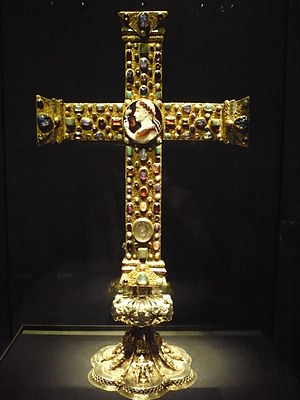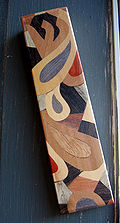- Decorative arts
-
 Chinese bowl, Northern Sung dynasty, 11th or 12th century, porcelaneous pottery with celadon glaze
Chinese bowl, Northern Sung dynasty, 11th or 12th century, porcelaneous pottery with celadon glaze
The decorative arts is traditionally a term for the design and manufacture of functional objects. It includes interior design, but not usually architecture. The decorative arts are often categorized in opposition to the "fine arts", namely, painting, drawing, photography, and large-scale sculpture, which generally have no function other than to be seen. Decorative arts, or furnishings, may be fixed (for example, wallpaper), or moveable (for example, carpets). Applied art includes the decorative arts but also graphic design and other categories, such as industrial design, which may overlap with decorative art. In general the term "decorative art" is not much used of contemporary work, which tends to be called design whereas in art history the terms minor arts or lesser arts have been used which explains the contempt often expressed by those focused on 'fine art'.
Contents
Distinction from fine arts
 The front side of the Cross of Lothair (c. 1000), a classic example of "Ars Sacra"
The front side of the Cross of Lothair (c. 1000), a classic example of "Ars Sacra"
The distinction between decorative and fine arts has essentially risen from the post-Renaissance art of the West, where it is for the most part meaningful. It is much less so when applied to the art of other cultures and periods, where the most highly-regarded works often include those in "decorative" media, or all works are in such media. For example, Islamic art in many periods and places consists entirely of the decorative arts, as does the art of many traditional cultures, and in Chinese art the distinction is less useful than in Europe. Even in Europe, the distinction is unhelpful for Early Medieval art, where although "fine arts" such as manuscript illumination and monumental sculpture existed, the most prestigious works, commissioned from the best artists, tended to be in goldsmith work or cast metals such as bronze. Large-scale wall-paintings were apparently much less regarded, relatively crudely executed, and rarely mentioned in contemporary sources; they were probably seen as a cheap but inferior substitute for mosaic, which in this period must be treated as a fine art, though in recent centuries contemporary production has tended to be seen as decorative. The term "ars sacra" ("sacred arts") is sometimes used for medieval Christian art in metal, ivory, textiles and other high-value materials from this period, though this does not cover the even rarer survivals of secular works.
Modern understanding of the art of many cultures tends to be distorted by the modern privileging of fine art media over others, as well as the very different survival rates of works in different media. Works in metal, above all in precious metals, are liable to be "recycled" as soon as they fall from fashion, and were often used by owners as repositories of wealth, to be melted down when extra money was needed. Illuminated manuscripts have a much higher survival rate, especially in the hands of the church, as there was little value in the materials and they were easy to store.
The promotion of the fine arts over the decorative in European thought can largely be traced to the Renaissance, when Italian theorists such as Vasari promoted artistic values, exemplified by the artists of the High Renaissance, that placed little value on the cost of materials or the amount of skilled work required to produce a work, but instead valued artistic imagination and the individual touch of the hand of a supremely gifted master such as Michelangelo, Raphael or Leonardo da Vinci, reviving to some extent the approach of antiquity. Most European art during the Middle Ages had been produced under a very different set of values, where both expensive materials and virtuoso displays in difficult techniques had been highly valued. In China both approaches had co-existed for many centuries: ink and wash painting, mostly of landscapes, was to a large extent produced by and for the scholar-bureaucrats or "literati", and was intended as an expression of the artist's imagination above all, while other major fields of art, including the very important Chinese ceramics produced in effectively industrial conditions, were produced according to a completely different set of artistic values.
Some decorative arts
 Decorative metalwork designed in the Art Deco style by Maurice Ascalon and manufactured by the Pal-Bell Company during the 1940s.
Decorative metalwork designed in the Art Deco style by Maurice Ascalon and manufactured by the Pal-Bell Company during the 1940s.
- Ceramic art (that is Pottery)
- Glassware, including some stained glass and studio glass
- Furniture
- Hardstone carving, including pietra dura work and engraved gems
- metalwork, especially by goldsmiths
- jewellery
- ivory carving and bone carving
- textile arts
- Some mosaics, and all micromosaics
- Wallpaper
- Fretwork
- Fold-forming
See also
- American craft
- Applied art
- Arts and crafts
- Faux painting
- History of decorative arts
- Ornament (architecture)
- Customised buses and trucks in Pakistan
References
- Fiell, Charlotte and Peter, eds. Decorative Art Yearbook (one for each decade of the 20th century). Translated. Bonn: Taschen, 2000.
- Fleming, John and Hugh Honour. Dictionary of the Decorative Arts. New York: Harper and Row, 1977.
- Frank, Isabelle. The Theory of Decorative Art: An Anthology of European and American Writings, 1750–1940. New Haven: Yale University Press, 2000.
- Campbell, Gordon. The Grove Encyclopedia of Decorative Arts. New York: Oxford University Press, 2006.
- Thornton, Peter. Authentic Decor: Domestic Interior, 1620–1920. London: Seven Dials, 2000.
External links
- Decorating with Art, Antiques and Collectibles
- Home Economics Archive: Tradition, Research, History (HEARTH)
An e-book collection of over 1,000 books on home economics spanning 1850 to 1950, created by Cornell University's Mann Library. Includes several hundred e-books on decorative art and design, particularly that created within the home. - Victoria and Albert Museum
- Argentine Decorative Art Museum
- The Bard Graduate Center (BGC) for Studies in the Decorative Arts, Design and Culture
- Parsons/Cooper-Hewitt Program in the History of Decorative Arts & Design
- Cooper-Hewitt National Design Museum, Smithsonian Institution
- Digital Library for the Decorative Arts and Material Culture - electronic resources
- Metropolitan Museum of Art American decorative arts collection
- National Gallery of Art decorative arts collection
- Bagatti Valsecchi Museum, Milan, Italy
- Museum of the City of New York Decorative Arts Collection
- Decorative Artists in Canada
- Winterthur Program in American Material Culture
- Jane Issa on hotel art in Jamaica
Categories:- Decorative arts
- Art genres
- Art media
- Interior design
- Architectural elements
- Gardening aids
- Design
Wikimedia Foundation. 2010.

